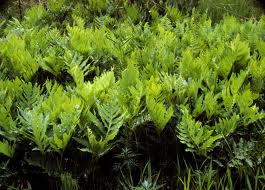|
This hardy, decidous (leaf-losing) Fern is a native of the North Temperate Zone, including North America. The Sensitive Fern or Bead Fern, as it is commonly called, is a creeping, fern that loves wet soil. It has broad, triangular fronds, which are finely divided into segments. It is pale green, stained with pink when young. There are two types of fronds on this Fern; infertile (don't produce spores) and fertile (produce spores). The fertile fronds are constricted in growth and densely covered with sporangia (spore-bearing structures). They grow in the centers of the plants.
Pot Cultivation
The Sensitive Fern should be planted in humus-rich soil, in a partially shaded position. Planting should be done in the spring and the crowns should be set 2 or 3 feet apart. Plants growing near water or in wet soil will have plenty of water and need little attention, but those planted in borders must be kept well-watered in dry weather. The dead fronds shouldn't be removed until the spring, because they protect the crowns during the winter.
Propagation
These Ferns may be divided in the fall or winter. Spores may also be sown as soon as they are ripe in the summer, or they may be stored in seed packets and sown some other time. To tell if spores are ripe, choose a frond that has brownish spores and place in a paper bag. Hang the bag to dry for a few days. The brownish powder at the bottom of the bag are the ripe spores. Sprinkle these thinly on the top of finely sifted compost that is in small pans filled halfway with crocks. It is wise to sterilize the compost, crocks and pans by baking before planting the spores. Set a pane of glass over the pots, which are then set in saucers of water. Cover the pots with paper. The prothallia (prothallia are the thin, green, heart-shaped structures that bear a number of root hairs that attach to the soil and extract nourishment) that develop from the spores are pricked out in small clusters and placed half an inch apart in pans of sifted compost. When they're visible as tiny plants just press them into the surface of the compost. They must be kept moist by standing them in water. Don't water them from above until they develop their first small fronds. When they're large enough they can be potted in 3-inch pots and, later, into larger ones. Ferns aren't cross-pollinated as flowering plants are. The spores of two or more kinds are mixed and planted together and hybridization takes place naturally in the prothallia stage. The male element from the prothallia of one kind swims in the film of moisture and enters the female structure on the prothallia of another kind of fern, and fertilization takes place.
 |
O. sensibilis. |
Varieties O. sensibilis. |